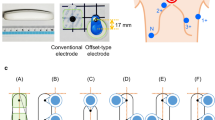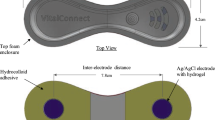Abstract
Automatic pacemaker capture verification is important for maintaining safety and low energy consumption in pacemaker patients. A new algorithm was developed, based on impedance measurement between pacing electrode poles, which reflects the distribution of the conducting medium between the poles and changes with effective contraction. Data acquired during pacemaker implant in 17 subjects were analysed, with intracardiac impedance recorded while pacing was performed in the ventricle at varying energies, resulting in multiple-captured and non-captured beats. The impedance signals of all captured/non-captured beats were analysed using three different algorithms, based on the morphology of the impedance signal. The algorithm decision for each beat was compared with an actual capture or noncapture, as determined from the simultaneous recording of surface ECG. Two of the three algorithms (Z1 and Zn) were based on impedance values, and one (Zn 1) was based on the first derivative of the impedance. Z1 was based on a single sample, whereas Zn ′ and Zn ′ were based on several samples in each beat. The total accuracy for each was Z1: 43%, Zn: 87%, Zn ′: 92%. It was concluded that impedance-based capture verification is feasible, that a multiple rather than single sample approach for signal classification is both feasible and superior, and that first derivative analysis with multiple samples (Zn ′) provides the best results.
Similar content being viewed by others
References
Alt, E., Krigler, C., Fothoui, P., Eillhaus R., Combs, W., Heinz, M., andHayes, D. (1992): ‘Feasibility of using intracardiac impedance measurements for capture detection’,Pacing Clin. Electrophysiol.,15, pp. 1873–1879
Chirife, R., Ortega, D. F., andSalazar, A. I. (1993): ‘Feasibility of measuring relative right ventricular volumes and ejection fraction with implantable rhythm control devices’,Pacing Clin. Electrophysiol.,16, pp. 1673–1683
Clarke, M., Liu, B., Schuller, H., Binner, B., Kennergen, C., Guerola, M., Weinman, P. andOhm, O. J. (1998): ‘Automatic adjustment of pacemaker stimulation output correlated with continuously monitored capture thresholds: a multicentre study, European Microny Study Group’,Pacing Clin. Electrophysiol.,21, pp. 1567–1575
Feld, G. K., Love, C. J., Carmelo, J., andMarsella, R. (1992): ‘A new pacemaker algorithm for continuous capture verification and automatic threshold determination: elimination of pacemaker afterpotential utilizing a triphasic charge balancing system’,Pacing Clin. Electrophysiol.,15, pp. 171–178
Geddes, L. A., Hoff, H. E., Mello, A., andPalmer, C. (1966): ‘Continuous measurement of ventricular stroke volume by electrical impedance’,Cardiovasc. Res. Center Bull.,4, pp. 118–131
Gelvan, D., Crystal, E., Dokumaci, B., Goldshmid, Y., andOvsyshcher, I. E. (2003): ‘Effects of modern pacing algorithms on generator longevity: a predictive analysis’,Pacing Clin. Electrophysiol.,26, pp. 1796–1802
Kadhiresan, V. A., Olive, A., Gronick, C., Spinelli, J. andVillalta, D. (1999): ‘Automatic capture verification by chargeneural sensing’,Pacing Clin. Electrophysiol.,22, pp. 73–78
Kennergren, C., Larsson, B., Uhrenius, A., andGadler, F. (2003): ‘Clinical experience with an automatic threshold tracking algoritm study’,Pacing Clin. Electrophysiol.,26, pp 2219–2224
Kubieck, W. (1966): ‘Development and evaluation of an impedance cardiac output system’,Aerospace Med.,34, p. 1208
Luria, D., Gurevitz, O., Bar Lev, D., Tkach, Y., Eldar, M., andGlikson, M. (2004): ‘Use of automatic threshold tracking function with non low polarization leads: risk for algorithm malfunction’,Pacing Clin. Electrophysiol.,27, pp. 453–459.
Mckay, R. G., Spears, J. R., Aroesty, J. M., Baim, D. S., Royal, H. D., Heller, G. V., Lincoln, W., Salo, R. W., Braunwald, E., andGrossman, W. (1984): ‘Instantaneous measurement of left and right ventricular stroke volume and pressure-volume relationships with an impedance catheter’,Circulation,69, pp. 703–710
Ribiero, A. L., Rincon, L. G., Oliviera, B. G., Vinha, C. R., Melatto, D., Torres, E., Barros, V. C., andLevine, P. A. (2004): ‘Automatic adjustment of pacing output in the clinical setting’,Am. Heart. J.,147, pp. 127–131
Rushmer, R. F. (1953): ‘Intaracardiac plethysmography’,Am. J. Physiol.,174, pp. 171–174
Salo, R. W., Pederson, B. D., Olive, A. L., Lincoln, W. C., andWallner, T. G. (1984): ‘Continuous ventricular volume assessment for diagnosis and pacemaker control’.Pacing Clin. Electrophysiol.,7, pp. 1267–1272.
Salo, R. W., Wallner, T. G., andPederson, B. D. (1986): ‘Measurement of ventricular volume by intracardiac impedance: theoretical and empirical approaches’,IEEE Trans. Biomed. Eng.,33, pp. 189–195
Stokes, K., andBorzin, G. (1985): ‘The electrode-biointerface: Stimulation’, inBarlod, S. S. (Ed.): ‘Modern cardiac pacing’ (Futura Publication Co. Inc., 1985), pp. 33–77
Author information
Authors and Affiliations
Corresponding author
Rights and permissions
About this article
Cite this article
Yaacoby, E., Akselrod, S., Eldar, M. et al. Algorithm for ventricular capture verification based on the mechanical evoked response. Med. Biol. Eng. Comput. 43, 511–515 (2005). https://doi.org/10.1007/BF02344733
Received:
Accepted:
Issue Date:
DOI: https://doi.org/10.1007/BF02344733




